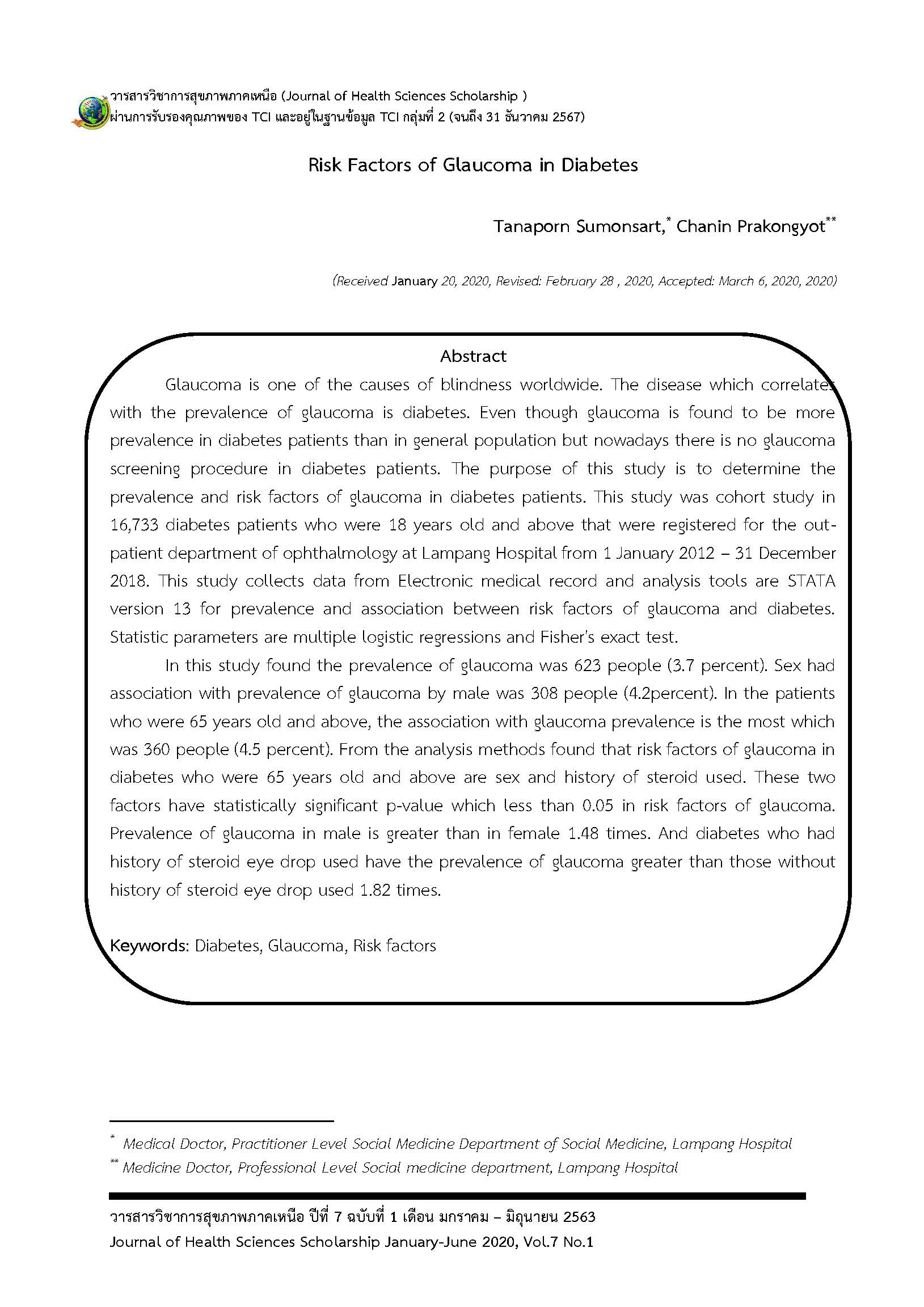ปัจจัยเสี่ยงของโรคต้อหินในผู้ป่วยเบาหวาน
คำสำคัญ:
โรคเบาหวาน, โรคต้อหิน, ปัจจัยเสี่ยงบทคัดย่อ
โรคต้อหินเป็นสาเหตุของการสูญเสียการมองเห็นอย่างถาวรในทั่วโลก ปัจจัยที่เกี่ยวข้องกับโรคต้อหิน คือ โรคเบาหวาน แม้ว่าโรคต้อหินพบในผู้ป่วยเบาหวานได้มากกว่าประชากรทั่วไป แต่ยังไม่มีแนวทางการคัดกรองโรคต้อหินในผู้ป่วยเบาหวานในปัจจุบัน งานวิจัยนี้มีวัตถุประสงค์เพื่อหาความชุก และปัจจัยเสี่ยงของโรคต้อหินในผู้ป่วยเบาหวานการศึกษานี้ เป็นแบบ cohort study ในประชากรผู้ป่วยเบาหวาน16,733 คนอายุมากกว่าเท่ากับ 18 ปี ที่มารับการตรวจห้องตรวจนอกจักษุ โรงพยาบาลลำปาง ระหว่าง 1 มกราคม 2555 -31 ธันวาคม 2561 การศึกษานี้เก็บข้อมูลจากเวชระเบียนอิเลคทรอนิคส์ และ เครื่องมือที่ในการวิเคราะห์คือ STATA เวอร์ชั่น 13 เพื่อหาความชุก และความสัมพันธ์ระหว่างปัจจัยเสี่ยงในผู้ป่วยเบาหวานกับโรคต้อหิน โดยมีค่าสถิติที่ใช้คือ multiple logistic regressions และ Fisher's exact test
ผลการวิจัยพบว่า ความชุกของโรคต้อหินเท่ากับ 623 (ร้อยละ3.7) คน เพศมีความสัมพันธ์กับความชุกของโรคต้อหินโดยเพศชายเท่ากับ 308(ร้อยละ4.2) คน โดยในอายุมากกว่าเท่ากับ 65 ปี พบความสัมพันธ์ระหว่างความชุกของโรคต้อหินมากที่สุด เท่ากับ 360 (ร้อยละ4.5) คน เมื่อวิเคราะห์ปัจจัยที่มีความเสี่ยงต่อการเกิดต้อหินใน ผู้ป่วยเบาหวานที่มีอายุมากกว่า 65 ปีขึ้นไป พบว่า เพศ และประวัติการได้รับยาหยอดตากลุ่มสเตียรอยด์ เป็นปัจจัยที่มีความเสี่ยงต่อการเกิดต้อหินอย่างมีนัยสำคัญทางสถิติที่ระดับ 0.05 โดยเพศชายมีความชุกของโรคต้อหินมากกว่าเพศหญิง 1.48 เท่า และผู้ที่มีประวัติการได้รับยาหยอดตากลุ่มสเตียรอยด์ความชุกของโรคต้อหินมากกว่ากลุ่มที่ไม่ได้ใช้ยาหยอดตากลุ่มสเตียรอยด์ 1.82 เท่า
เอกสารอ้างอิง
Aekplakorn, W., Stolk, R. P., Neal, B., Suriyawongpaisal, P., Chongsuvivatwong, V., Cheepudomwit,
S., & Woodward, M. (2003). The prevalence and management of diabetes in Thai adults: the international collaborative study of cardiovascular disease in Asia. Diabetes care, 26(10), 2758-2763.
Bourne et al., (2003). Prevalence of glaucoma in Thailand: a population based survey in Rom Klao District, Bangkok. British journal of ophthalmology, 87(9), 1069-1074.
Beynat et al., (2008).Combined glaucoma and diabetic retinopathy screening in Burgundy. Journal francais d'ophtalmologie, 31(6 Pt 1), 591-596.
Chua et al.,(2019).Inter-relationship between ageing, body mass index, diabetes, systemic blood pressure and intraocular pressure in Asians: 6-year longitudinal study. British Journal of Ophthalmology, 103(2), 196-202.
Cubey, R. B. (1976). Glaucoma following the application of corticosteroid to the skin of the eyelids. British Journal of Dermatology, 95(2), 207-208.
Culture Surveillance Bureau. (2012).glaucoma warning in chatter [Online], Available : https://www.m-culture.go.th/surveillance/ewt_news.php?nid=795& filename=index(2014,5 March) (in Thai)
Davari, M. H., Kazemi, T., & Rezai, A. (2014). A survey of the relationship between serum cholesterol and triglyceride to glaucoma: A case control study. Journal of Basic and Applied Sciences, 10, 39-43.
Godel, V., Feiler‐Ofry, V., & Stein, R. (1972). Systemic steroids and ocularular fliud dynamics. I: Analysis of the Sample as a Whole. Influence of Dosage and Duration of Therapy. Acta ophthalmologica, 50(5), 655-663.
Hashemi et al., (2019). Prevalence and risk factors of glaucoma in an adult population from Shahroud, Iran. Journal of Current Ophthalmology, 31(4), 366-372.
Isipradit et al., (2014). The first rapid assessment of avoidable blindness (RAAB) in Thailand. PloS one, 9(12), e114245.
Jenchitr et al., (2004). The prevalence of glaucoma in a population-based study in Lampang. J of Hlth Sc, 13(2): 200-215
Klein, B. E., Klein, R., & Jensen, S. C. (1994). Open-angle glaucoma and older-onset diabetes: the Beaver Dam Eye Study. Ophthalmology, 101(7), 1173-1177.
Langman et al., (2005). Systemic hypertension and glaucoma: mechanisms in common and co-occurrence. British Journal of Ophthalmology, 89(8), 960-963.
Müskens et al., (2007). Systemic antihypertensive medication and incident open-angle glaucoma. Ophthalmology, 114(12), 2221-2226.
Phulke et al.,(2017). Steroid-induced glaucoma: An avoidable irreversible blindness. Journal of current glaucoma practice, 11(2), 67.
Tham et al., (2014). Global prevalence of glaucoma and projections of glaucoma burden through 2040: a systematic review and meta-analysis. Ophthalmology, 121(11), 2081-2090.
Wang, S., & Bao, X. (2019). Hyperlipidemia, Blood Lipid Level, and the Risk of Glaucoma: A Meta-Analysis. Investigative ophthalmology & visual science, 60(4), 1028-1043.
Zhao et al., (2015). Diabetes, fasting glucose, and the risk of glaucoma: a meta-analysis. Ophthalmology, 122(1), 72-78.
Zhao, Y.-X., & Chen, X.-W. (2017). Diabetes and risk of glaucoma: systematic review and a Meta-analysis of prospective cohort studies. International journal of ophthalmology, 10(9), 1430.

ดาวน์โหลด
เผยแพร่แล้ว
ฉบับ
ประเภทบทความ
สัญญาอนุญาต
บทความ ข้อมูล เนื้อหา รูปภาพ ฯลฯ ที่ได้รับการตีพิมพ์ในวารสารวารสารวิชาการสุขภาพภาคเหนือ ถือเป็นลิขสิทธิ์ของวารสารวารสารวิชาการสุขภาพภาคเหนือ หากบุคคลหรือหน่วยงานใดต้องการนำทั้งหมดหรือส่วนหนึ่งส่วนใดไปเผยแพร่ต่อหรือเพื่อกระทำการใดๆ จะต้องได้รับอนุญาตเป็นลายลักอักษรจากวารสารวารสารวิชาการสุขภาพภาคเหนือก่อนเท่านั้น
เนื้อหาและข้อมูลในบทความที่ลงตีพิมพ์ในวารสารวิชาการสุขภาพภาคเหนือถือเป็นข้อคิดเห็นและความรับผิดชอบของผู้เขียนบทความโดยตรงซึ่งกองบรรณาธิการวารสาร ไม่จำเป็นต้องเห็นด้วย หรือร่วมรับผิดชอบใดๆ
อนึ่ง ข้อความและข้อคิดเห็นต่างๆ เป็นของผู้เขียนบทความนั้นๆ ไม่ถือเป็นความเห็นของวารสารฯ และวารสารฯ ไม่จำเป็นต้องเห็นด้วยกับข้อความและข้อคิดเห็นใดๆ ของผู้เขียน วารสารฯ ขอสงวนสิทธิ์ในการพิจารณาตีพิมพ์ตามความเหมาะสม รวมทั้งการตรวจทานแก้ไขหรือขัดเกลาภาษาให้ถูกต้องตามเกณฑ์ที่กำหนด


